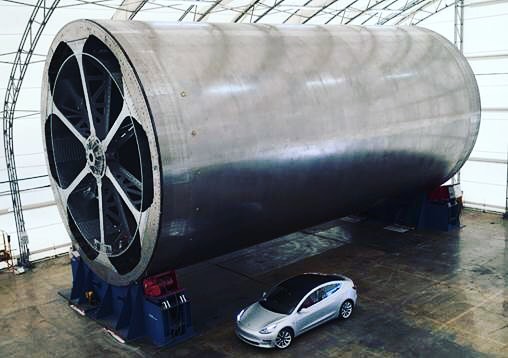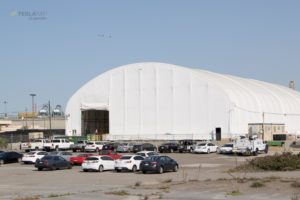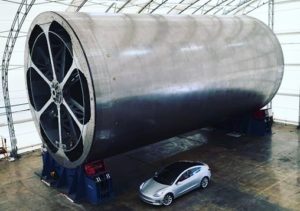

News
SpaceX posts first BFR-dedicated job posting – wanna build a Mars rocket?
SpaceX has published the first job posting specifically dedicated to BFR, the company’s ambitious fully-reusable Mars rocket and multipurpose launch vehicle. Currently targeting the first half of 2019 for initial hop tests with a prototype spaceship (upper stage) and 2020 for the first full-up orbital tests of the booster and ship. Job postings specific to BFR signify the beginning of serious R&D expansion and acceleration.
Since its announcement in September 2017, SpaceX has made slow but steady (visible) progress on its path to integrated BFR prototype production, including the construction of a giant temporary tent, the successful lease of a large plot of land intended to support the first dedicated BFR factory at Port of Los Angeles, and accepted shipments of massive tooling that will be used to construct the huge rocket’s first carbon composite propellant tanks.
- Lots of cars at the BFR tent. This also provides a sense of scale for the tent’s absolutely massive access flaps. (Pauline Acalin)
- SpaceX’s first major BFR and BFS fabrication tooling, likely being stored temporarily in a tent at Port of San Pedro. Note the tent framework at the top. (Elon Musk)
- Images corroborated the location of the giant mandrel tool inside the Port of San Pedro tent, April 2018. (Pauline Acalin)
First revealed in 2016 in the form of the 33% larger Interplanetary Transport System (ITS), CEO Elon Musk provided a second update in 2017 that showed an optimized, smaller rocket with all the same goals, known as BFR (Big F- Rocket). The rocket’s main propulsion, a methane and liquid oxygen-fueled engine known as Raptor, also saw its 2016 targets lowered partially, dropping its targeted maximum thrust to about double (from 3000 kN to 1700 kN) the current Merlin 1D engines powering the Falcon family.
Tellingly, the job posted on Monday, June 11, sounds very similar to those posted for equivalent engineering positions with Falcon 9 and Dragon. Titled “BFR Build Engineer”, the listing describes many of the same skills and tasks prospective employees would expect to find if hired, with most focused on SpaceX’s culture of constant improvement. The same is expected from build engineers and engineers, in general, focused on SpaceX’s current operational launch vehicles and spacecraft, strongly suggesting that the BFR effort is taking its very first steps from an experimental research program to something more akin to an operational branch of the launch company.
What is definitely new is the specific focus on expertise with advanced forms of welding, particularly with joining distinct composite and metal components, as will be required throughout BFR.
- SpaceX’s subscale Raptor engine has completed more than 1200 seconds of testing in less than two years. (SpaceX)
- Shown here is a prototype of the original 12m diameter ITS tankage. BFR’s tanks will be 25% narrower, and thus easier to manufacture. (SpaceX)
Read the best parts of the job listing below:
“The BFR (Big Falcon Rocket) is a massive next generation launch vehicle and spacecraft designed to carry [hu]mankind to the moon, Mars, and beyond. Also capable of flying humans from Los Angeles to New York in 25 minutes, the BFR will eventually replace the current Falcon 9, Falcon Heavy, and Dragon programs as the primary vehicle for all SpaceX missions.”
“The goal of this team is to investigate, test, and develop new hardware, software, and automation efforts capable of supporting advanced metallic and composite joining methods for the BFR. Focusing on friction stir welding, EB [electron-beam] welding, and composite tank lamination, the BFR Build Engineer is responsible for delivering results on critical projects with a highly demanding and fast-paced schedule”
- Drive the technology development for manufacturing cryogenic composite tanks through research, mechanical/destructive testing and sub-scale manufacturing
- Work closely with vehicle analysts and manufacturing team to ensure solutions meet the requirements for vehicle design as well as the manufacturing processes
- Partner with engineering & production teams to generate ideas, designs, and improvements for current and next-generation vehicles
- Strong background in composite structures with knowledge of automated fiber placement, autoclaves and composite design criteria

Elon Musk
Elon Musk and Tesla AI Director share insights after empty driver seat Robotaxi rides
The executives’ unoccupied tests hint at the rapid progress of Tesla’s unsupervised Robotaxi efforts.

Tesla CEO Elon Musk and AI Director Ashok Elluswamy celebrated Christmas Eve by sharing personal experiences with Robotaxi vehicles that had no safety monitor or occupant in the driver’s seat. Musk described the system’s “perfect driving” around Austin, while Elluswamy posted video from the back seat, calling it “an amazing experience.”
The executives’ unoccupied tests hint at the rapid progress of Tesla’s unsupervised Robotaxi efforts.
Elon and Ashok’s firsthand Robotaxi insights
Prior to Musk and the Tesla AI Director’s posts, sightings of unmanned Teslas navigating public roads were widely shared on social media. One such vehicle was spotted in Austin, Texas, which Elon Musk acknowleged by stating that “Testing is underway with no occupants in the car.”
Based on his Christmas Eve post, Musk seemed to have tested an unmanned Tesla himself. “A Tesla with no safety monitor in the car and me sitting in the passenger seat took me all around Austin on Sunday with perfect driving,” Musk wrote in his post.
Elluswamy responded with a 2-minute video showing himself in the rear of an unmanned Tesla. The video featured the vehicle’s empty front seats, as well as its smooth handling through real-world traffic. He captioned his video with the words, “It’s an amazing experience!”
Towards Unsupervised operations
During an xAI Hackathon earlier this month, Elon Musk mentioned that Tesla owed be removing Safety Monitors from its Robotaxis in Austin in just three weeks. “Unsupervised is pretty much solved at this point. So there will be Tesla Robotaxis operating in Austin with no one in them. Not even anyone in the passenger seat in about three weeks,” he said. Musk echoed similar estimates at the 2025 Annual Shareholder Meeting and the Q3 2025 earnings call.
Considering the insights that were posted Musk and Elluswamy, it does appear that Tesla is working hard towards operating its Robotaxis with no safety monitors. This is quite impressive considering that the service was launched just earlier this year.
Elon Musk
Starlink passes 9 million active customers just weeks after hitting 8 million
The milestone highlights the accelerating growth of Starlink, which has now been adding over 20,000 new users per day.

SpaceX’s Starlink satellite internet service has continued its rapid global expansion, surpassing 9 million active customers just weeks after crossing the 8 million mark.
The milestone highlights the accelerating growth of Starlink, which has now been adding over 20,000 new users per day.
9 million customers
In a post on X, SpaceX stated that Starlink now serves over 9 million active users across 155 countries, territories, and markets. The company reached 8 million customers in early November, meaning it added roughly 1 million subscribers in under seven weeks, or about 21,275 new users on average per day.
“Starlink is connecting more than 9M active customers with high-speed internet across 155 countries, territories, and many other markets,” Starlink wrote in a post on its official X account. SpaceX President Gwynne Shotwell also celebrated the milestone on X. “A huge thank you to all of our customers and congrats to the Starlink team for such an incredible product,” she wrote.
That growth rate reflects both rising demand for broadband in underserved regions and Starlink’s expanding satellite constellation, which now includes more than 9,000 low-Earth-orbit satellites designed to deliver high-speed, low-latency internet worldwide.
Starlink’s momentum
Starlink’s momentum has been building up. SpaceX reported 4.6 million Starlink customers in December 2024, followed by 7 million by August 2025, and 8 million customers in November. Independent data also suggests Starlink usage is rising sharply, with Cloudflare reporting that global web traffic from Starlink users more than doubled in 2025, as noted in an Insider report.
Starlink’s momentum is increasingly tied to SpaceX’s broader financial outlook. Elon Musk has said the satellite network is “by far” the company’s largest revenue driver, and reports suggest SpaceX may be positioning itself for an initial public offering as soon as next year, with valuations estimated as high as $1.5 trillion. Musk has also suggested in the past that Starlink could have its own IPO in the future.
News
NVIDIA Director of Robotics: Tesla FSD v14 is the first AI to pass the “Physical Turing Test”
After testing FSD v14, Fan stated that his experience with FSD felt magical at first, but it soon started to feel like a routine.

NVIDIA Director of Robotics Jim Fan has praised Tesla’s Full Self-Driving (Supervised) v14 as the first AI to pass what he described as a “Physical Turing Test.”
After testing FSD v14, Fan stated that his experience with FSD felt magical at first, but it soon started to feel like a routine. And just like smartphones today, removing it now would “actively hurt.”
Jim Fan’s hands-on FSD v14 impressions
Fan, a leading researcher in embodied AI who is currently solving Physical AI at NVIDIA and spearheading the company’s Project GR00T initiative, noted that he actually was late to the Tesla game. He was, however, one of the first to try out FSD v14.
“I was very late to own a Tesla but among the earliest to try out FSD v14. It’s perhaps the first time I experience an AI that passes the Physical Turing Test: after a long day at work, you press a button, lay back, and couldn’t tell if a neural net or a human drove you home,” Fan wrote in a post on X.
Fan added: “Despite knowing exactly how robot learning works, I still find it magical watching the steering wheel turn by itself. First it feels surreal, next it becomes routine. Then, like the smartphone, taking it away actively hurts. This is how humanity gets rewired and glued to god-like technologies.”
The Physical Turing Test
The original Turing Test was conceived by Alan Turing in 1950, and it was aimed at determining if a machine could exhibit behavior that is equivalent to or indistinguishable from a human. By focusing on text-based conversations, the original Turing Test set a high bar for natural language processing and machine learning.
This test has been passed by today’s large language models. However, the capability to converse in a humanlike manner is a completely different challenge from performing real-world problem-solving or physical interactions. Thus, Fan introduced the Physical Turing Test, which challenges AI systems to demonstrate intelligence through physical actions.
Based on Fan’s comments, Tesla has demonstrated these intelligent physical actions with FSD v14. Elon Musk agreed with the NVIDIA executive, stating in a post on X that with FSD v14, “you can sense the sentience maturing.” Musk also praised Tesla AI, calling it the best “real-world AI” today.













